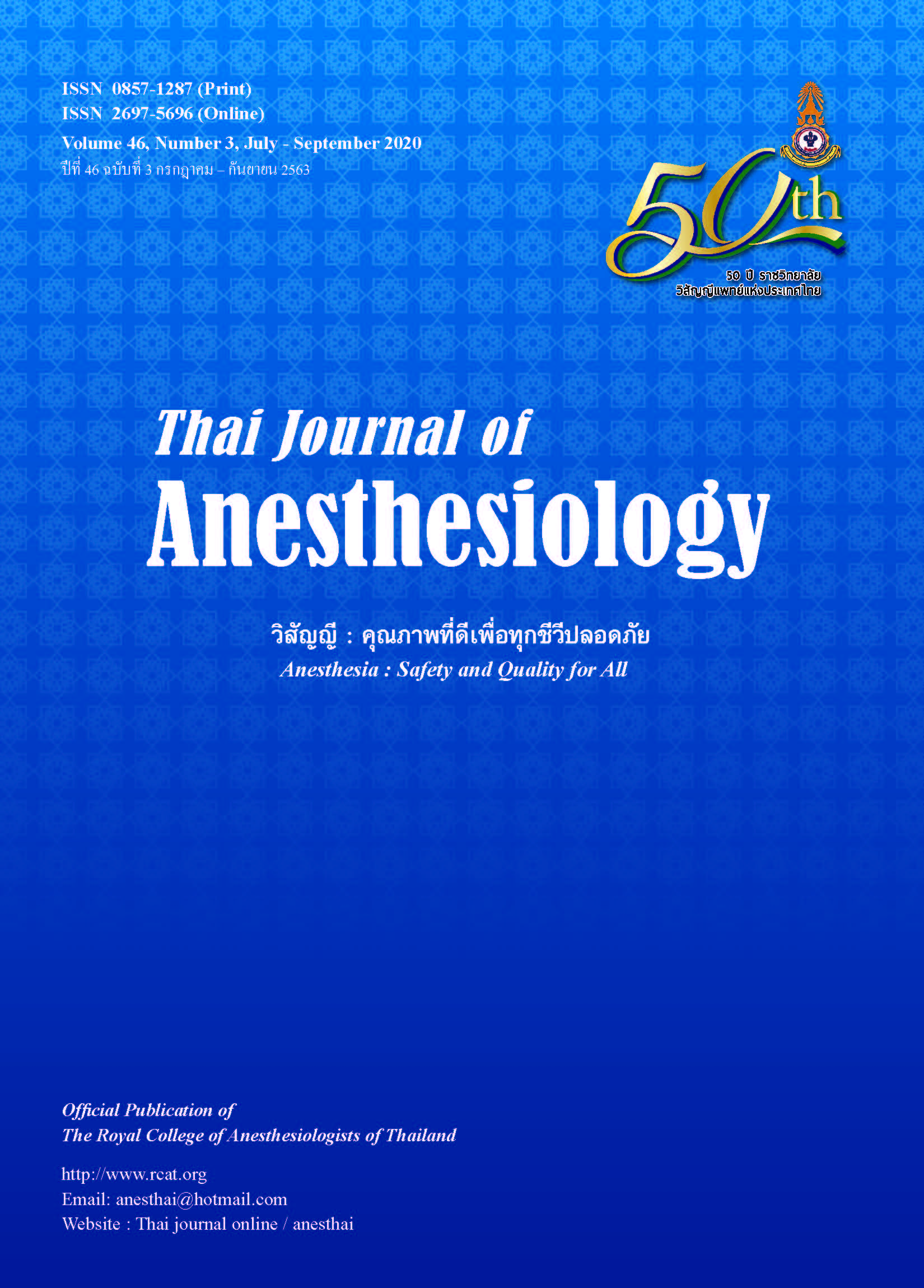Outcomes of Cardiopulmonary Resuscitation in Neurologic-neurosurgical Patients at Prasat Neurological Institute
Main Article Content
Abstract
Background: Cardiac arrest in neurologic-neurosurgical
patients was different from general patients. Few studies
addressed in cardiopulmonary resuscitation (CPR)
outcomes and factors associated with the outcome of CPR
in neurologic-neurosurgical patients. This study evaluated
the outcomes of in-hospital CPR and factors associated
with the outcomes of CPR in neurologic-neurosurgical
patients in the tertiary neurological center, Thailand.
Methods: This study is a retrospective cohort study, collecting
the data of all patients with the primary neurological
diagnosis who experienced cardiac arrest and received
CPR from October 2005 to September 2018. We performed
descriptive and logistic regression analysis to identify the
factors affecting CPR. We used the adjusted odds ratios
(AOR) and 95% confidence intervals (CI) to report
the factors associated with the return of spontaneous
circulation (ROSC) and survival to hospital discharge.
Results: There were 184 CPR reports. Ninety-three
(50.5%) were male. The mean age was 61+18 (13-98)
years. Ninety cardiac arrests (48.9%) occurred in the
monitored area. The most common neurological diagnosis
was stroke (41.3%). The most common cause of cardiac
arrest was sepsis (30.4%). The initial EKG rhythm was
asystole (59.8 %). We found ROSC in 98 patients (53.2%).
Twenty-one patients (11.4%) discharged from the hospital
with the modified Rankin Scale (MRS) mean 3 + 1 (1-5).
Factors associated with survival to discharge was
non-asystole rhythms (AOR = 1.2; 95% CI 1.07-1.4; P =
0.003).
Conclusion: The rate of survival to hospital discharge of
neurologic-neurosurgical patients was 11.4%. The modified
Rankin Scale (MRS) mean of patients who survived was
a moderate disability. Non-asystole rhythms were the only
factor associated with survival to hospital discharge.
Article Details
References
cardiac massage. JAMA 1960;173:1064-7.
2. Tian J, Kaufman DA, Zarich S, et al. American Heart
Association National Registry for Cardiopulmonary
Resuscitation Investigators. Outcomes of critically ill patients
who received cardiopulmonary resuscitation. Am J Respir
Crit Care Med 2010;182:501-6.
3. Suraseranivongse S, Chawaruechai T, Saengsung P, et al.
Outcome of cardiopulmonary resuscitation in a 2300-bed
hospital in a developing country. Resuscitation 2006;71:
188-93.
4. Krittayaphong R, Saengsung P, Chawaruechai T, et al.
Factors predicting outcome of cardiopulmonary resuscitation
in a developing country: the Siriraj cardiopulmonary
resuscitation registry. J Med Assoc Thai 2009;92:618-23.
5. Tokgözoglu SL, Batur MK, Topçuoglu MA, et al. Effects of
stroke localization on cardiac autonomic balance and
sudden death. Stroke 1999;30:1307-11.
6. Rabinstein AA, McClelland RL, Wijdicks EF, et al. Cardiopulmonary
resuscitation in critically ill neurologic-neurosurgical
patients. Mayo Clin Proc 2004;79:1391-5.
7. Yi HJ, Kim YS, Ko Y, et al. Factors associated with survival
and neurological outcome after cardiopulmonary resuscitation
of neurosurgical intensive care unit patients. Neurosurgery
2006;59:838-45
8. Siriphuwanun V, Punjasawadwong Y, Lapisatepun W, et al.
The initial success rate of cardiopulmonary resuscitation and
its associated factors in patients with cardiac arrest within
24 hours after anesthesia for an emergency surgery. Risk
Manag Healthc Policy 2014;7:65-76.
9. Akavipat P, Sookplung P, Boonsombat T et al. Cardiac Arrest
and Death in Neurosurgery: An Analysis of Perioperative
Anesthetic Adverse Events in Thailand. Journal of Neuroanaesthesiology
and Critical Care 2018;5:87-93.
10. Sandroni C, Ferro G, Santangelo S, et al. In-hospital cardiac
arrest: survival depends mainly on the effectiveness of the
emergency response. Resuscitation. 2004;62:291-7.
11. Skrifvars MB, Rosenberg PH, Finne P, et al. Evaluation of the
in-hospital Utstein template in cardiopulmonary resuscitation
in secondary hospitals. Resuscitation 2003;56:275-82.
12. Cooper S, Janghorbani M, Cooper G. A decade of
in-hospital resuscitation: outcomes and prediction of
survival? Resuscitation 2006;68:231-7.
13. Tok D, Keles GT, Toprak V, Topcu I. Assessment of
in-hospital cardiopulmonary resuscitation using Ustein
template in a university hospital. Tohoku J Exp Med 2004;
202:265-73.
14. Abella BS, Alvarado JP, Myklebust H, et al. Quality of
cardiopulmonary resuscitation during in-hospital cardiac
arrest, JAMA 2005;293:305-10.
15. Chan JC, Wong TW, Graham CA. Factors associated with
survival after in-hospital cardiac arrest in Hong Kong. Am J
Emerg Med 2013;3: 883-85.
16. Jintapakorn W, Tasanapitak J, Intaraksa P. Results of
cardiopulmonary resuscitation (CPR) at Songklanagarind
Hospital. Songkla Med J 2005;23:223-27.
17. Saklayen M, Liss H, Markert R. In-hospital cardiopulmonary
resuscitation: survival in 1 hospital and literature review.
Medicine (Baltimore) 1995;74:163-75.
18. Kutsogiannis DJ, Bagshaw SM, Laing B, Brindley PG.
Predictors of survival after cardiac or respiratory arrest in
critical care units. CMAJ 2011;183:1589-95.
19. Hershey CO, Fisher L. Why outcome of cardiopulmonary
resuscitation in general wards is poor. Lancet 1982;1:31-4.
20. Karetzky M1, Zubair M, Parikh J. Cardiopulmonary resuscitation
in intensive care unit and non-intensive care unit patients.
Immediate and long-term survival. Arch Intern Med 1995;155:
1277-80.
21. Siriphuwanun V, Punjasawadwong Y, Lapisatepun W et al.
Prognostic factors for death and survival with or without
complications in cardiac arrest patients receiving CPR
within 24 hours of anesthesia for emergency surgery. Risk
Manag Healthc Policy 2014;7:199-210.
22. Cooper S. Evans C. Resuscitation Predictor Scoring scale
for in-hospital cardiac arrests. Emerg Med J 2003;20:6-9.
23. Jones-Crawford JL, Parish DC, Smith BE, et al. Resuscitation
in the hospital: circadian variation of cardiopulmonary arrest.
Am J Med 2007;120:158-64.
24. López-Herce J, Del Castillo J, Matamoros M, et al. Factors
associated with mortality in pediatric in-hospital cardiac
arrest: a prospective multicenter multinational observational
study. Intensive Care Med 2013;39:309-18.
25. Wong SC, Tariq SM. Cardiac arrest following foreign-body
aspiration. Respiratory Care 2011;4:527-29.
26. Kashif M, Talib Hashmi HR, Khaja M. Early recognition of
foreign body aspiration as the cause of cardiac arrest. Case
Rep Crit Care 2016;2016:1329234. doi:10.1155/2016/1329234
27. Nolan JP, Morley PT, Vanden Hoek TL et al. Therapeutic
hypothermia after cardiac arrest: an advisory statement by
the advanced life support task force of the International
Liaison Committee on Resuscitation. Circulation 2003;108:
118-21.
28. Peberdy MA, Callaway CW, Neumar RW et al. Part 9:
post-cardiac arrest care: 2010 American Heart Association
Guidelines for Cardiopulmonary Resuscitation and
Emergency Cardiovascular Care. Circulation 2010;122:
S768-86.
29. Callaway CW, Donnino MW, Fink EL et al. Part 8: Post-cardiac
arrest care: 2015 American Heart Association Guidelines
Update for Cardiopulmonary Resuscitation and Emergency
Cardiovascular Care. Circulation2015;132:S465-82.


